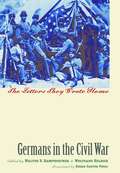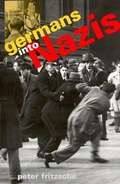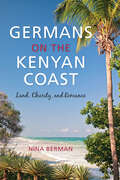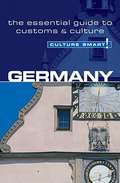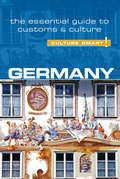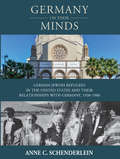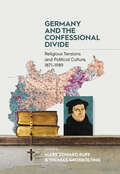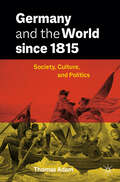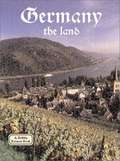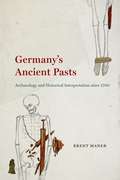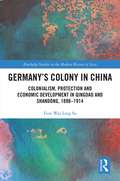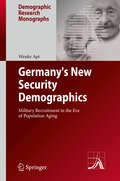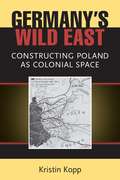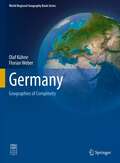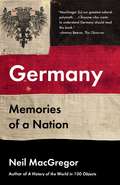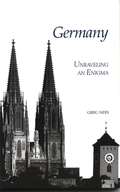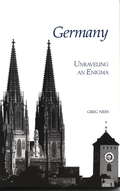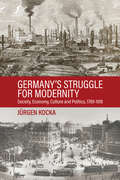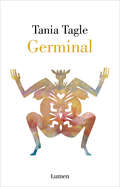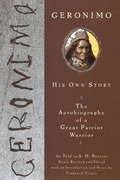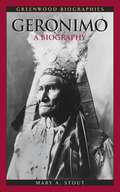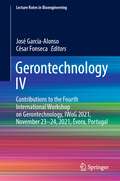- Table View
- List View
Germans in the Civil War
by Walter D. Kamphoefner Wolfgang HelbichGerman Americans were one of the largest immigrant groups in the Civil War era, and they comprised nearly 10 percent of all Union troops. Yet little attention has been paid to their daily lives--both on the battlefield and on the home front--during the war. This collection of letters, written by German immigrants to friends and family back home, provides a new angle to our understanding of the Civil War experience and challenges some long-held assumptions about the immigrant experience at this time. Originally published in Germany in 2002, this collection contains more than three hundred letters written by seventy-eight German immigrants--men and women, soldiers and civilians, from the North and South. Their missives tell of battles and boredom, privation and profiteering, motives for enlistment and desertion and for avoiding involvement altogether. Although written by people with a variety of backgrounds, these letters describe the conflict from a distinctly German standpoint, the editors argue, casting doubt on the claim that the Civil War was the great melting pot that eradicated ethnic antagonisms.
Germans into Nazis
by Peter FritzscheIn this dramatically plotted book, organized around crucial turning points in 1914, 1918, and 1933, Peter Fritzsche explains why the Nazis were so popular and what was behind the political choice made by the German people.
Germans on the Kenyan Coast: Land, Charity, and Romance
by Nina Berman“Shed[s] light on the romantic, psychosexual and psychosocial, and economic entanglements that tie German tourists to their Kenyan hosts.” —Daily NationDiani, a coastal town on the Indian Ocean, is significantly defined by a large European presence that has spurred economic development and is also supported by close relationships between Kenyans and European immigrants and tourists. Nina Berman looks carefully at the repercussions that these economic and social interactions have brought to life on the Kenyan coast. She explores what happens when poorer and less powerful members of a community are forced to give way to profit-based real estate development, what it means when most of Diani’s schools and water resources are supplied by funds from immigrants, and what the impact of mixed marriages is on notions of kinship and belonging as well as the economy. This unique story about a small Kenyan town also recounts a wider tale of opportunity, oppression, resilience, exploitation, domination, and accommodation in a world of economic, political, and social change.“In this richly detailed book, Nina Berman tracks the influx of thousands of German-speaking tourists and residents, especially in the 1990s, and the making of a distinctive Kenyan-European cultural enclave in the coastal community of Diani as many of these visitors choose to extend their stay as long-term residents.” —Ann Biersteker, author of Masomo ya Kisasa: Contemporary Readings in Swahili“An informative and thought-provoking work that deserves to be read by scholars of Kenya and those interested in globalized structures of gentrification, north-south humanitarian assistance, and love and romance in Africa.” —African Studies Quarterly
Germans to Poles
by Hugo ServiceAt the end of the Second World War, mass forced migration and population movement accompanied the collapse of Nazi Germany's occupation and the start of Soviet domination in East-Central Europe. Hugo Service examines the experience of Poland's new territories, exploring the Polish Communist attempt to 'cleanse' these territories in line with a nationalist vision, against the legacy of brutal wartime occupations of Central and Eastern Europe by Nazi Germany and the Soviet Union. The expulsion of over three million Germans was intertwined with the arrival of millions of Polish settlers. Around one million German citizens were categorised as 'native Poles' and urged to adopt a Polish national identity. The most visible traces of German culture were erased. Jewish Holocaust survivors arrived and, for the most part, soon left again. Drawing on two case studies, the book exposes how these events varied by region and locality.
Germany (Major European Union Nations)
by Ida WalkerEver since Germany formed in 1871, it has been a major world player. It was even a founding member of the EU in 1952. Although Germany's 20th-century history was often dark, it is now one of the most prosperous and stable countries in the world. It has struggled during the global recession, but it has also been a leader in facing the EU's economic difficulties. Discover more about this exciting, modern nation!
Germany - Culture Smart!
by Barry TomalinCulture Smart! provides essential information on attitudes, beliefs and behavior in different countries, ensuring that you arrive at your destination aware of basic manners, common courtesies, and sensitive issues. These concise guides tell you what to expect, how to behave, and how to establish a rapport with your hosts. This inside knowledge will enable you to steer clear of embarrassing gaffes and mistakes, feel confident in unfamiliar situations, and develop trust, friendships, and successful business relationships.Culture Smart! offers illuminating insights into the culture and society of a particular country. It will help you to turn your visit-whether on business or for pleasure-into a memorable and enriching experience. Contents include* customs, values, and traditions* historical, religious, and political background* life at home* leisure, social, and cultural life* eating and drinking* do's, don'ts, and taboos* business practices* communication, spoken and unspoken"Culture Smart has come to the rescue of hapless travellers." Sunday Times Travel"... the perfect introduction to the weird, wonderful and downright odd quirks and customs of various countries." Global Travel"...full of fascinating-as well as common-sense-tips to help you avoid embarrassing faux pas." Observer"...as useful as they are entertaining." Easyjet Magazine"...offer glimpses into the psyche of a faraway world." New York Times
Germany - Culture Smart!
by Barry TomalinWith the FIFA World Cup in its pocket Germany is feeling its social, political, and economic power once again. After organizing a successful World Cup in 2006 and winning it against Argentina in Brazil in 2014, Germany sees a note of confidence, even triumphalism, permeating the country. As a European leader committed to the success of the EU and the Eurozone, Germany is a leading driver of European affairs. It emerged from the recession of 2008 as the strongest economic power in Europe, and German manufacturing, product brand value, and exports are going from strength to strength. What are the implications of this new world confidence for German society itself? In the last few years we have seen East and West Germany come together socially and achieve a greater degree of economic balance as a long-term result of German re-unification. At the same time German society itself is internationalizing, with increased immigration and the adaptation of age-old values and attitudes to a multinational, multicultural era. Traditional attitudes of formality and rigid protocol in business are softening as German business globalizes. This new, updated edition of Culture Smart! Germany examines these changes. It explains how German traditional values and working methods are adapting to take advantage of international opportunities and global society while maintaining the commitment to quality, organization, and time that marks out German business life. It shows how the traditional differences between Germany's regions are lessening, enabling society to come together and better absorb new immigrants, and above all how Germans are losing the fear and guilt associated with their twentieth-century wars and finding a new voice on the international stage.
Germany On Their Minds: German Jewish Refugees in the United States and Relationships with Germany, 1938–1988 (Studies in German History #25)
by Anne C. SchenderleinThroughout the 1930s and early 1940s, approximately ninety thousand German Jews fled their homeland and settled in the United States, prior to that nation closing its borders to Jewish refugees. And even though many of them wanted little to do with Germany, the circumstances of the Second World War and the postwar era meant that engagement of some kind was unavoidable—whether direct or indirect, initiated within the community itself or by political actors and the broader German public. This book carefully traces these entangled histories on both sides of the Atlantic, demonstrating the remarkable extent to which German Jews and their former fellow citizens helped to shape developments from the Allied war effort to the course of West German democratization.
Germany and the Confessional Divide: Religious Tensions and Political Culture, 1871-1989
by Mark Edward Ruff and Thomas GroßböltingFrom German unification in 1871 through the early 1960s, confessional tensions between Catholics and Protestants were a source of deep division in German society. Engaging this period of historic strife, Germany and the Confessional Divide focuses on three traumatic episodes: the Kulturkampf waged against the Catholic Church in the 1870s, the collapse of the Hohenzollern monarchy and state-supported Protestantism after World War I, and the Nazi persecution of the churches. It argues that memories of these traumatic experiences regularly reignited confessional tensions. Only as German society became increasingly secular did these memories fade and tensions ease.
Germany and the World since 1815: Society, Culture, and Politics
by Thomas AdamThis textbook provides a history of modern Germany, locating the country’s social, cultural, and political developments within their proper global and transnational context. The author argues that most developments in German culture, society, and politics throughout the nineteenth and twentieth centuries were caused by wider global and transnational trends. A history of the German people rather than the German state, the book focusses on non-state and non-government actors, intercultural transfers, and applies the approach of ‘thick description’ to analysing the creation of German culture, society, and identity from the era of the Napoleonic wars right up to the present post-unification Germany. This includes an examination of German migrants’ journeys to their new homes in the Americas and, thus, the creation of a global German diaspora with cultural and social networks beyond its home country’s borders. The book further focusses on the transfers that connected German society and culture with those of other countries; for instance, chapters cover the transfer of football from England to Germany, the transfer of the Christmas holiday tradition from Germany to other countries, and the development of eugenics in Germany within its global context.
Germany the Land (Lands, Peoples, and Cultures Ser.)
by Kathryn LaneIntroduces the geography, cities, transportation, economy, and wildlife of Germany.
Germany's Ancient Pasts: Archaeology and Historical Interpretation since 1700
by Brent ManerIn Germany, Nazi ideology casts a long shadow over the history of archaeological interpretation. Propaganda, school curricula, and academic publications under the regime drew spurious conclusions from archaeological evidence to glorify the Germanic past and proclaim chauvinistic notions of cultural and racial superiority. But was this powerful and violent version of the distant past a nationalist invention or a direct outcome of earlier archaeological practices? By exploring the myriad pathways along which people became familiar with archaeology and the ancient past—from exhibits at local and regional museums to the plotlines of popular historical novels—this broad cultural history shows that the use of archaeology for nationalistic pursuits was far from preordained. In Germany’s Ancient Pasts, Brent Maner offers a vivid portrait of the development of antiquarianism and archaeology, the interaction between regional and national history, and scholarly debates about the use of ancient objects to answer questions of race, ethnicity, and national belonging. While excavations in central Europe throughout the eighteenth and nineteenth centuries fed curiosity about the local landscape and inspired musings about the connection between contemporary Germans and their “ancestors,” antiquarians and archaeologists were quite cautious about using archaeological evidence to make ethnic claims. Even during the period of German unification, many archaeologists emphasized the local and regional character of their finds and treated prehistory as a general science of humankind. As Maner shows, these alternative perspectives endured alongside nationalist and racist abuses of prehistory, surviving to offer positive traditions for the field in the aftermath of World War II. A fascinating investigation of the quest to turn pre- and early history into history, Germany’s Ancient Pasts sheds new light on the joint sway of science and politics over archaeological interpretation.
Germany's Colony in China: Colonialism, Protection and Economic Development in Qingdao and Shandong, 1898-1914 (Routledge Studies in the Modern History of Asia)
by Fion Wai SoThis book explores the economic development of the northern Chinese city of Qingdao, which was held by Germany as a colony from 1898 to 1914. It focuses especially on the economic polices of the German colonial government and of the provincial government of the neighbouring Chinese province of Shandong, considering amongst other issues free trade and protection, the impact of the Gold Standard and assistance given to particular companies. The book shows how the Qingdao and Shandong economies fitted into overall East Asian and global trade patterns and how during this period these economies became more fully integrated into the world economy. The book concludes by discussing how although there was a great deal of co-operation between the Qingdao and Shandong governments, there were also growing tensions.
Germany's New Security Demographics
by Wenke AptMilitary recruitment will become more difficult in times of demographic aging. The question arises whether demographic change will constrain the capacity of aging states like Germany to conduct foreign policy and pursue their national security interests. Since contemporary military operations still display a strong human element, particular scrutiny is given to the empirical analysis of the determinants of military propensity and military service among youth. An additional human capital projection until 2030 illustrates how the decline in the youth population will interact with trends in educational attainment and adolescent health to further complicate military recruitment in the future. A concluding review of recruiting practices in other NATO countries provides insight in best-practice policy options to reduce the military's sensitivity to demographic change. Following this approach, the book gives prominence to a topic that has thus far been under-represented in the greater discussion of demographic change today, namely the demographic impact on international affairs and strategic calculations.
Germany's Wild East: Constructing Poland as Colonial Space
by Kristin KoppIn the nineteenth and early twentieth centuries, representations of Poland and the Slavic East cast the region as a primitive, undeveloped, or empty space inhabited by a population destined to remain uncivilized without the aid of external intervention. These depictions often made direct reference to the American Wild West, portraying the eastern steppes as a boundless plain that needed to be wrested from the hands of unruly natives and spatially ordered into German-administrated units. While conventional definitions locate colonial space overseas, Kristin Kopp argues that it was possible to understand both distant continents and adjacent Eastern Europe as parts of the same global periphery dependent upon Western European civilizing efforts. However, proximity to the source of aid translated to greater benefits for Eastern Europe than for more distant regions.
Germany, Poland, and Postmemorial Relations
by Kristin Kopp Joanna NiżyńskaCovering the period following the collapse of communism, the unification of Germany, and Poland's accession to the EU, this collection focuses on the interdependencies of German, Polish, and Jewish collective memories and their dialogic, transnational character, showing the collective nature of postmemory and the pressures that shape it.
Germany: Geographies of Complexity (World Regional Geography Book Series)
by Olaf Kühne Florian WeberThis book addresses the highly differentiated spatial, social, cultural and demographic structure(s) of Germany, with a particular focus on the reciprocal relations between different levels of spatial development. The historical development of Germany serves as a background in order to provide context for the development of spatially relevant ideas and ideals (whether in relation to politics, landscape, or culture). In this regard, questions of divergence and convergence become highly salient. The book makes the complexity of spatial and social developments in Germany comprehensible. The neopragmatic approach adopted here allows bringing together different theoretical strands while providing a basis for independent regional geographic research at the same time. Beginning with an overview of the physical structures of Germany which provides the material point of departure for the societal development of Germany, key aspects of the German history are discussed. Particular attention is paid to the reciprocal influence between material substrate and notions of landscape. Here, specific ‘German’ trajectories of aesthetic and normative conceptions of landscape become clear. A common theme throughout the book are questions of divergence and of efforts towards convergence, which become evident when considering past and present economic, political, and demographic developments. Efforts to tackle current challenges, such as adapting to climate change and mitigating it, or securing raw materials, also become apparent. The complexity of spatial processes in Germany is illustrated in case study regions dealing with the challenges of structural change in traditional industrial regions (such as the Ruhr area), or e.g. efforts of Berlin to position and find itself as the capital of a unified Germany. Overall, the book shows how theory-driven regional geographic research can make spatiotemporal complexities tangible and comprehensible.
Germany: Memories of a Nation
by Neil MacgregorFor the past 140 years, Germany has been the central power in continental europe. Twenty-five years ago a new German state came into being. How much do we really understand this new Germany, and how do its people understand themselves?Neil MacGregor argues that, uniquely for any European country, no coherent, overarching narrative of Germany's history can be constructed, for in Germany both geography and history have always been unstable. Its frontiers have constantly shifted. Königsberg, home to the greatest German philosopher, Immanuel Kant, is now Kaliningrad, Russia; Strasbourg, in whose cathedral Wolfgang von Geothe, Germany's greatest writer, discovered the distinctiveness of his country's art and history, now lies within the borders of France. For most of the five hundred years covered by this book Germany has been composed of many separate political units, each with a distinct history. And any comfortable national story Germans might have told themselves before 1914 was destroyed by the events of the following thirty years.German history may be inherently fragmented, but it contains a large number of widely shared memories, awarenesses, and experiences; examining some of these is the purpose of this book. MacGregor chooses objects and ideas, people and places that still resonate in the new Germany--porcelain from Dresden and rubble from its ruins, Bauhaus design and the German sausage, the crown of Charlemagne and the gates of Buchenwald--to show us something of its collective imagination. There has never been a book about Germany quite like it.From the Hardcover edition.
Germany: Unraveling An Enigma (Interact Ser.)
by Greg NeesSo we think we know a lot about Germans? After all, more Germans have immigrated to the United States than any other ethnic group, and fifty million American citizens currently claim German heritage. The truth is though, Germans are different from us in more ways than we may know. Greg Nees, in this new title in the InterAct sseries, Germany: Unraveling an Enigma, does an outstanding job of explaining those cultural differences that we most need to know in order to have effective and fulfilling interactions with the Germans. Nees explores major German cultural themes: the need for order and obedience to rules and regulations, the insistence on clarity of thought, compartmentalization, the penchant for rational thinking and the love of abstract debate, the sharp distinction between insiders and outsiders, a strong sense of duty, and German communication patterns. As a business consultant who has lived and worked many years with Germans, Greg Nees gives special attention to the German social market economy and to cultural differences in the workplace. Perhaps most valuable, in his last chapter he looks to the future as Germany seeks to create a new identity in the twenty-first century, dealing with such issues as multiculturalism, Americanization, changing lifestyles, the European Union, and globalization.
Germany: Unraveling an Enigma
by Gregory NeesSo we think we know a lot about Germans? After all, more Germans have immigrated to the United States than any other ethnic group, and fifty million American citizens currently claim German heritage. The truth is, though, Germans are different from us—in more ways than we may know. Greg Nees, in this new InterAct, Germany: Unraveling an Enigma, does an outstanding job of explaining those cultural differences that we most need to know in order to have effective and fulfilling interactions with the Germans. Nees explores major German cultural themes: the need for order and obedience to rules and regulations, the insistence on clarity of thought, compartmentalization, the penchant for rational thinking and the love of abstract debate, the sharp distinction between insiders and outsiders, a strong sense of duty, and German communication patterns. As a business consultant who has lived and worked many years with Germans, Greg Nees gives special attention to the German social market economy and to cultural differences in the workplace. Perhaps most valuable, in his last chapter he looks to the future as Germany seeks to create a new identity in the twenty-first century, dealing with such issues as multiculturalism, Americanization, changing lifestyles, the European Union, and globalization.
Germany’s Struggle for Modernity: Society, Economy, Culture, and Politics, 1780-1918
by Jürgen Kocka Volker BerghahnIn the historiography of modern Germany, the nineteenth century’s innovations marks a period of seismic change. From accelerating demographic growth to growing secularization and the rise of nationalism, it was a century which laid the foundations for both a civil society and the dictatorships of the twentieth century. In this comprehensive history of Germany from 1780 to 1918, Jürgen Kocka re-examines the transformative interactions that took place between society, economy, culture, and politics. Innovatively resituating these developments within a wider context of conflict and transformation in Europe, this book illuminates new ways to understand the emergence of classical modernity within the nineteenth century.
Germinal
by Tania TagleGerminal es un ensayo que acompaña el proceso de traer a una persona a este mundo desde un entendimiento de la angustia y la belleza que eso implica. Un libro que conmueve y que abre espacio, también, para pensar cómo se insertan esos procesos en el pensamiento y la cultura y cómo podemos transformarlos Con un enfoque íntimo y auténtico Tania Tagle nos comparte sus dudas y sus reflexiones en torno al embarazo, el parto y la crianza, entretejidas con la exploración de conceptos como lo monstruoso, el milagro y la maravilla. Así dialogamos al mismo tiempo con ella y con pensadores romanos, como Tito Livio, entre otros, para rastrear dónde se gesta y cómo se transforma la idea de monstruo, al mismo tiempo que se transforma el cuerpo de una embarazada; o en la segunda parte, donde Tagle se acerca al momento del parto concebido como milagro, alumbramiento, trazando la genealogía del término a través del judaísmo, de los mitos griegos o de San Agustín. Finalmente, llegamos al momento de la adquisición del lenguaje, a la crianza, con esa sorpresa, ese thauma que pone en conversación a Tales de Mileto, a María Zambrano o a Sócrates.
Geronimo
by GeronimoEnter the world of Geronimo Stilton, where another funny adventure is always right around the corner. Each book is a fast-paced adventure with lively art and a unique format kids 7-10 will love. Ah, there's nothing like a relaxing vacation on the beach! I would spread out by the crystal-clear water with a good book. What more could a mouse want? At least, that was the plan. But somehow, my vacations never seem to go according to plan. Instead of a beautiful seaside resort, I found myself in a fleabag hotel that was falling down around my ears! Oh, would I ever be able to relax and enjoy my vacation??
Geronimo: A Biography
by Mary A. StoutApache warrior Geronimo led one of the last major independent Indian uprisings, and personified the struggle of Native Americans during westward expansion. Aimed at high school and undergraduate students, this biography provides an account of Geronimo's life from his traditional Apache upbringing to his final days as a celebrity prisoner of war, within the context of key historical and cultural events of his lifetime, including Native American traditions. The biography draws on primary sources such as Geronimo's autobiography and contemporary newspaper accounts, and is illustrated with b&w historical photos. A timeline and a glossary are also included. Stout is a librarian at Pima Community College in Tucson. She has published six books on Native American tribes. Annotation c2010 Book News, Inc., Portland, OR (booknews.com)
Gerontechnology IV: Contributions to the Fourth International Workshop on Gerontechnology, IWoG 2021, November 23–24, 2021, Évora, Portugal (Lecture Notes in Bioengineering)
by José García-Alonso César FonsecaThis book gathers peer-review contributions to the 4th International Workshop on Gerontechnology, IWoG 2021, held on November 23-24, 2021, in Évora, Portugal. They report on cutting-edge technologies and optimized workflows for promoting active aging and assisting elderly people at home, as well as in healthcare centers. They discuss the main challenges in the development, use and delivery of health care services and technologies. Not only they propose solutions for improving in practice the monitoring and management of health parameters and age-related diseases, yet they also describe improved approaches for helping seniors in their daily tasks and facilitating their communication and integration with assistive technologies, thus improving their quality of life, as well as their social integration. All in all, this book provides health professionals, researchers, and service providers with extensive information on the latest trends in the development and practical application of gerontechnology, with a special emphasis on improving quality of life of the elderly.
